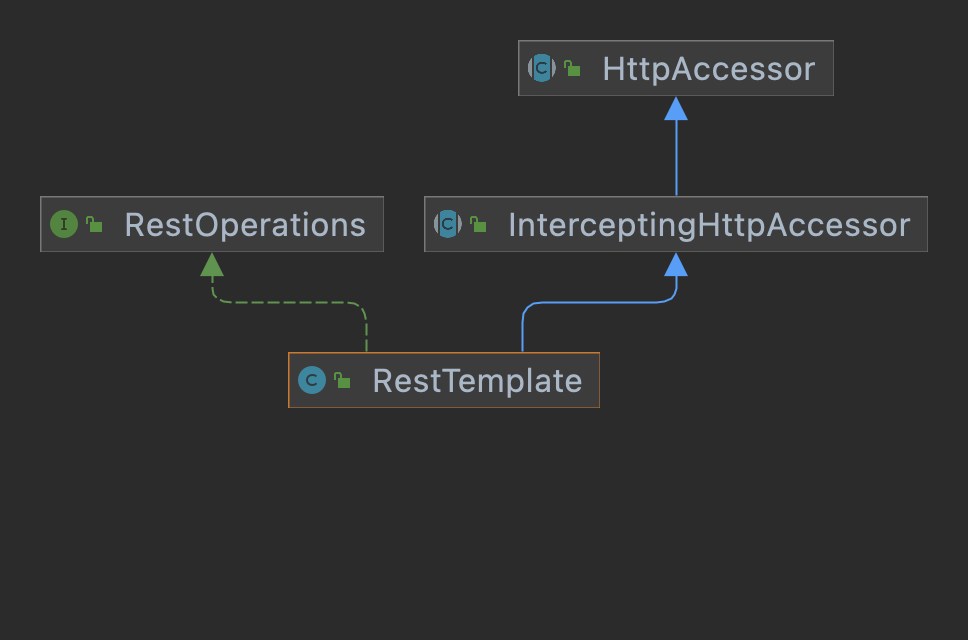目录 概述 构建 RestTemplate 使用 RestTemplateBuilder 使用 SimpleClientHttpRequestFactory 使用 Apache HTTPClient(推荐) RestTemplate 常用操作 RestTemplate – GET 请求 getForObject 方式 getForEntity 方式 RestTemplate – POST 请求 遇到的问题 Could not extract response: no suitable HttpMessageConverter found for response type [class Test1] and content type [application/json;charset=UTF-8] 附录 Spring RestTemplate 可以用来构建 Spring REST 客户端,访问其他服务提供的 REST API
概述 Spring 文档建议使用非阻塞、反应式的 WebClient 对象而不再是 RestTemplate,因为 WebClient 为同步、异步和流场景提供了有效支持,并且 RestTemplate 将在未来版本中弃用
但是以上的原因并不影响我们使用,因为学会一者之后就会触类旁通!
❓什么是 RestTemplate?
spring 框架提供的 RestTemplate 类可用于在应用中调用 rest 服务,它简化了与 http 服务的通信方式,统一了 RESTful 的标准,封装了 http 链接, 我们只需要传入 url 及返回值类型即可。相较于之前常用的 HttpClient,RestTemplate 是一种更优雅的调用 RESTful 服务的方式
在 Spring 应用程序中访问第三方 REST 服务与使用 Spring RestTemplate 类有关。RestTemplate 类的设计原则与许多其他 Spring 模板类(例如:JdbcTemplate、JmsTemplate)相同,为执行复杂任务提供了一种具有默认行为的简化方法「模板设计模式」
RestTemplate 默认依赖 JDK 提供 http 连接的能力 HttpURLConnection,如果有需要的话也可以通过 setRequestFactory 方法替换为例如 Apache HttpComponents、Netty或 OkHttp 等其它 HTTP library
组件 含义 HttpMessageConverter对象转换器 ClientHttpRequestFactory默认是 JDK 的 HttpURLConnection ResponseErrorHandler异常处理 ClientHttpRequestInterceptor请求拦截器
构建 RestTemplate 想要使用RestTemplate需要在 Spring IoC 容器中创建RestTemplate,这里给出了几种创建方式
使用 RestTemplateBuilder 基于 RestTemplateBuilder 的配置 1 2 3 4 5 6 7 8 9 @Bean public RestTemplate restTemplate (RestTemplateBuilder builder) { return builder .setConnectTimeout(Duration.ofMillis(3000 )) .setReadTimeout(Duration.ofMillis(3000 )) .build(); }
使用 SimpleClientHttpRequestFactory 基于 SimpleClientHttpRequestFactory 的配置 1 2 3 4 5 6 7 8 9 @Bean public RestTemplate restTemplate () { var factory = new SimpleClientHttpRequestFactory (); factory.setConnectTimeout(3000 ); factory.setReadTimeout(3000 ); return new RestTemplate (factory); }
使用 Apache HTTPClient(推荐) 基于 Apache HttpClient 的配置 1 2 3 4 5 6 7 8 9 10 11 12 13 14 15 16 17 18 19 20 21 @Autowired CloseableHttpClient httpClient; @Value("${api.host.baseurl}") private String apiHost;@Bean public RestTemplate restTemplate () {RestTemplate restTemplate = new RestTemplate (clientHttpRequestFactory());restTemplate.setUriTemplateHandler(new DefaultUriBuilderFactory (apiHost)); return restTemplate;} @Bean @ConditionalOnMissingBean public HttpComponentsClientHttpRequestFactory clientHttpRequestFactory () {HttpComponentsClientHttpRequestFactory clientHttpRequestFactory = new HttpComponentsClientHttpRequestFactory ();clientHttpRequestFactory.setHttpClient(httpClient); return clientHttpRequestFactory;}
RestTemplate 常用操作 1 2 3 4 5 6 7 8 9 10 11 12 13 14 15 16 17 18 19 20 21 22 23 24 25 26 public <T> T getForObject () ;public <T> ResponseEntity<T> getForEntity () ;public HttpHeaders headForHeaders () ;public URI postForLocation () ;public <T> T postForObject () ;public <T> ResponseEntity<T> postForEntity () ;public void put () ;public <T> T patchForObjectpublic void delete () public Set<HttpMethod> optionsForAllowpublic <T> ResponseEntity<T> exchange ()
上面提供的几个接口,基本是 Http 提供的几种访问方式的对应,如果想查看更加全面的 API 文档,可以访问官方 API 网址
RestTemplate – GET 请求 执行 GET 操作的可用方法有
API 方法 含义 getForObject(url, classType) 通过对 URL 执行 GET 来检索表示。响应(如果有)给定类型并返回 getForEntity(url, responseType) 通过对 URL 执行 GET 来检索作为ResponseEntity 的表示 exchange(url, httpMethod, requestEntity, responseType) 执行指定RequestEntity并将响应作为ResponseEntity 返回 execute(url, httpMethod, requestCallback, responseExtractor) 使用 HTTPMethod 访问给定的 URI 模板,设置相应的请求回调 RequestCallback,并且使用 ResponseExtractor 检查响应信息
❓可以使用的有两种方式 getForObject 和 getForEntity,那么这两种有什么区别?
从接口的签名上,可以看出一个是直接返回预期的对象,一个则是将对象包装到 ResponseEntity 封装类中 如果只关心返回结果,直接用 GetForObject 即可 如果除了返回的实体内容之外,还需要获取返回的 header 等信息,则可以使用 getForEntity getForObject 方式 具体方法调用原型如下:
1 2 3 4 5 public <T> T getForObject (String url, Class<T> responseType, Object... uriVariables) throws RestClientException ;public <T> T getForObject (String url, Class<T> responseType, Map<String, ?> uriVariables) throws RestClientException ;public <T> T getForObject (URI url, Class<T> responseType) throws RestClientException;
测试代码:
1 2 3 4 5 6 7 8 9 10 11 12 13 14 15 16 17 18 19 20 21 22 23 24 25 26 27 28 29 30 31 32 33 34 35 36 37 38 39 40 41 42 43 44 45 46 47 48 49 50 51 52 53 54 55 56 57 public class RestTestmplateTest { private RestTemplate restTemplate; @Before public void init () { restTemplate = new RestTemplate (); } @lombok .Data static class InnerRes { private Status status; private Data result; } @lombok .Data static class Status { int code; String msg; } @lombok .Data static class Data { long id; String theme; String title; String dynasty; String explain; String content; String author; } @Test public void testGet () { String url = "https://some.url/detail?id=1" ; InnerRes res = restTemplate.getForObject(url, InnerRes.class); System.out.println(res); url = "https://some.url/detail?id={?}" ; res = restTemplate.getForObject(url, InnerRes.class, "1" ); System.out.println(res); url = "https://some.url/detail?id={id}" ; Map<String, Object> params = new HashMap <>(); params.put("id" , 1L ); res = restTemplate.getForObject(url, InnerRes.class, params); System.out.println(res); URI uri = URI.create("https://some.url/detail?id=1" ); res = restTemplate.getForObject(uri, InnerRes.class); System.out.println(res); } }
❓对于getForObject(java.lang.String, java.lang.Class<T>, java.lang.Object...)方法,如何穿参数?
根据实际传参替换 url 模板中的内容,类似于 JDBC 中的占位符,使用模板中使用 {?} 来代表坑位,根据实际的传参顺序来填充
getForEntity 方式具体方法调用原型如下:
1 2 3 public <T> ResponseEntity<T> getForEntity (String url, Class<T> responseType, Object... uriVariables) throws RestClientException ;public <T> ResponseEntity<T> getForEntity (String url, Class<T> responseType, Map<String, ?> uriVariables) throws RestClientException;public <T> ResponseEntity<T> getForEntity (URI url, Class<T> responseType) throws RestClientException;
✨ResponseEntity封装中比原本直接获得 Object 多了两个东西:一个返回的 http 状态码 与 ResponseHeader 相关的头部信息
RestTemplate – POST 请求 post 请求除了有 forObject 和 forEntity 之外,还多了个 forLocation;其次 post 与 get 一个明显的区别就是传参方式不同,get 的参数一般会待在 url 中;post 更常见的是通过表单的方式提交
1 2 3 4 5 public <T> T postForObject (String url, @Nullable Object request, Class<T> responseType, Object... uriVariables) throws RestClientException ;public <T> T postForObject (String url, @Nullable Object request, Class<T> responseType, Map<String, ?> uriVariables) throws RestClientException;public <T> T postForObject (URI url, @Nullable Object request, Class<T> responseType) throws RestClientException ;
1 2 3 4 5 6 7 8 9 10 11 12 13 14 15 16 17 18 19 20 21 22 23 24 25 26 27 28 29 @Test public void testPost () { String url = "http://localhost:8080/post" ; String email = "xxx@gmail.com" ; String nick = "gg" ; MultiValueMap<String, String> request = new LinkedMultiValueMap <>(); request.add("email" , email); request.add("nick" , nick); URI uri = URI.create(url); String ans = restTemplate.postForObject(uri, request, String.class); ans = restTemplate.postForObject(url, request, String.class); request.clear(); request.add("email" , email); ans = restTemplate.postForObject(url + "?nick={?}" , request, String.class, nick); Map<String, String> params = new HashMap <>(); params.put("nick" , nick); ans = restTemplate.postForObject(url + "?nick={nick}" , request, String.class, params); }
上面分别给出了三种方法的调用方式,其中 post 传参区分为两种:uri 参数 和表单参数
uri 参数和 get 请求中一样,填充 uri 中模板坑位 表单参数,由 MultiValueMap 封装,同样是 key-value 结构 postForLocation是 POST 请求单独的 API,用于这样的场景:post 数据到一个 URL,返回新创建资源的 URL
1 2 3 4 5 6 7 public URI postForLocation (String url, @Nullable Object request, Object... uriVariables) throws RestClientException ; public URI postForLocation (String url, @Nullable Object request, Map<String, ?> uriVariables) throws RestClientException ; public URI postForLocation (URI url, @Nullable Object request) throws RestClientException ;
❓什么样的 REST 接口适合用这种 API 访问?
一般登录 or 注册都是 post 请求,而这些操作完成之后呢?大部分都是跳转到别的页面去了,这种场景下,就可以使用 postForLocation 了,提交数据,并获取返回的 URI,一个测试如下
遇到的问题 下面主要记录使用过程中遇到的问题
Could not extract response: no suitable HttpMessageConverter found for response type [class Test1] and content type [application/json;charset=UTF-8]出现以上问题,是由于 RestTemplate 构造的时候会缺省加载很多消息转换器,这里是由于没有增加序列化依赖,增加序列化字段相关的setter方法即可
附录 RestTemplate 用法说明 Spring 之 RestTemplate 使用小结 Spring RestTemplate springMvc 官方文档-RESTClient spring 官方文档 rest-endpoint 掌握 Spring 之 RestTemplate rest-client-access

